The Queen’s Royal Hussars
Due to the post-Cold War restructuring of the Armed Forces under ‘Options for Change,’ it was announced in 1990 that The Queen’s Own Hussars and The Queen’s Royal Irish Hussars would amalgamate to form The Queen’s Royal Hussars.
On 1st September 1993, the new Regiment was formed at an amalgamation parade held at Wessex Barracks, Bad Fallingbostel.
The Regiment moved to Cambrai Barracks, Catterick in July 1995 where it provided the Armoured Regiment to 19 Mechanised Brigade.
Six months later the Regiment found itself deploying Challenger 1 tanks to Bosnia as part of NATO’s British-led Implementation Force (IFOR).
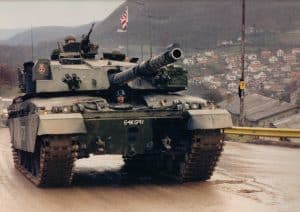
On patrol in Bosnia
The Regiment spent time in Bosnia as part of the 2nd Canadian Multi-National Brigade and was awarded The Canadian Forces Unit Commendation – the first time that this had been awarded to a foreign unit, and the first overseas commendation received by a British unit since the Korean War.
On return from Bosnia, the new Guidon was presented to the Regiment by the Colonel in Chief on 13 June 1997 in Catterick. the same year the Regiment deployed to Northern Ireland, this time in a dismounted role.
Having returned from Northern Ireland in March 1998 the Regiment conducted an Arms Plot move to Athlone Barracks, Sennelager in August, coming under the command of the 20th Armoured Brigade.
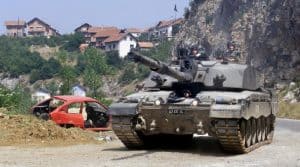
Kosovo, Challenger 2
Between July and November 1999, the Regiment successfully carried out the conversion to Challenger 2 Main Battle Tanks.
In August 2000 ‘B’ Squadron deployed their tanks to Kosovo as part of 1st Bn The Princess of Wales’s Royal Regiment Battle Group.
The squadron was responsible for guarding the international border with Serbia as part of NATO’s peacekeeping Kosovo Force (KFOR).
The remainder of the Regiment deployed to Kosovo as a Battlegroup from October 2001 to April 2002 in a dismounted role. ‘B’ Squadron deployed again to Kosovo in April 2002 with The Queen’s Royal Lancers Battlegroup.
In October 2002 the Regiment deployed two squadrons to Op FRESCO, the military’s emergency support during the UK fire-fighters dispute 2002-03. Cavalry soldiers found themselves fighting fires around Manchester and Liverpool when the firefighters were on strike during this period.
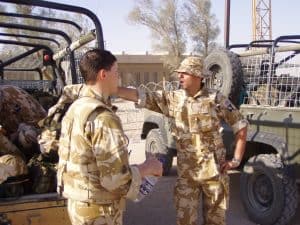
Op TELIC 3
In November 2003 the Regiment deployed to Iraq on Op TELIC 3 with one Squadron of Challenger 2 tanks and the remainder in the light role.
The majority of the Regiment was re-rolled in theatre to become the Security Sector Reform (SSR) Battlegroup and were responsible for the Iraqi Border Police, Judiciary and Prison service.
During this tour, LCpl Balmforth was awarded the Military Cross.
Shortly after the Regiment returned from Iraq, ‘A’ Squadron was deployed to Cyprus to overwatch part of the UN buffer zone between the Greeks and the Turks.
The Regiment was deployed again to Iraq (Op TELIC 8) between April and November 2006 in both armoured and light roles. The QRH Battlegroup was initially based in Al Amarah, Maysan province where the main camp received 286 insurgent rocket attacks in four months.
The Battlegroup received several operational awards during the tour including a Conspicuous Gallantry Cross, Military Crosses and several individuals Mentioned in Dispatches.
In May 2007 the Regiment exercised its right to the Freedom of the City of Birmingham parading through the city with the Guidon flying, swords drawn and bayonets fixed.
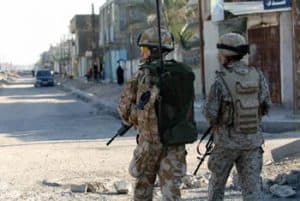
On patrol, Op TELIC 13
A further deployment to Iraq (Op TELIC 13) from November 2008 to June 2009 saw the Regiment engaged in various tasks ranging from providing the Armoured reserve, mentoring the Iraqi Army, guarding Iraq’s only port and escorting the logistical draw-down of British Forces from Basra to Kuwait.
At the same time, an independent Troop mounted in Viking Armoured vehicles deployed with the Royal Marines of 3 Commando Brigade to Afghanistan (Op HERRICK 9).
From September 2011 to March 2012 the Regiment deployed to Afghanistan (Op HERRICK 15).
During the tour the Regiment had troops deployed in various roles including a manoeuvre squadron based on Warthog Armoured vehicles, re-rolling a squadron to Light Role Infantry and mentoring the Afghan Army and Police.
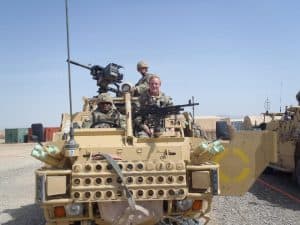
Op HERRICK 15
The QRH Battlegroup was responsible for the city of Lashkar Gar, the capital of Helmand province and its environs; becoming the first Armoured Regimental HQ to assume a ground-holding role in Afghanistan.
Sadly during this deployment, the Regiment suffered its first fatality on operations since the Korean War; Cpl Stanley died as a result of wounds caused by an Improvised Explosive Device.
On return from Afghanistan, the Regiment was tasked with providing security to several venues during the London 2012 Olympics after civilian security contractors failed to meet their obligations.
The Regiment deployed a squadron to Afghanistan (Op HERRICK 20) between May and September 2014. ‘C’ Squadron formed the nucleus of the Warthog Group, supplemented by dismounted troops from the 5th Battalion, The Rifles (5 RIFLES). As one of the final British mounted close combat units in theatre, the Warthog Group provided security to the draw-down from Camp BASTION by disrupting insurgent activity and conducting search operations, covering around 700 km, sustaining 171 contacts and ensuring security for the last British troops in Helmand.
Concurrently, the remaining Squadrons were deployed to Glasgow (Op COMET) in support of XX Commonwealth Games, reprising their role in Op OLYMPICS and providing security to stadia and critical infrastructure throughout the games.
In 2015, as a result of the Army 2020 reforms, the Regiment adopted a Type 56 structure, with four tank troops in each sabre squadron and joining 3 (UK) Division to begin a three-year readiness and training cycle.

